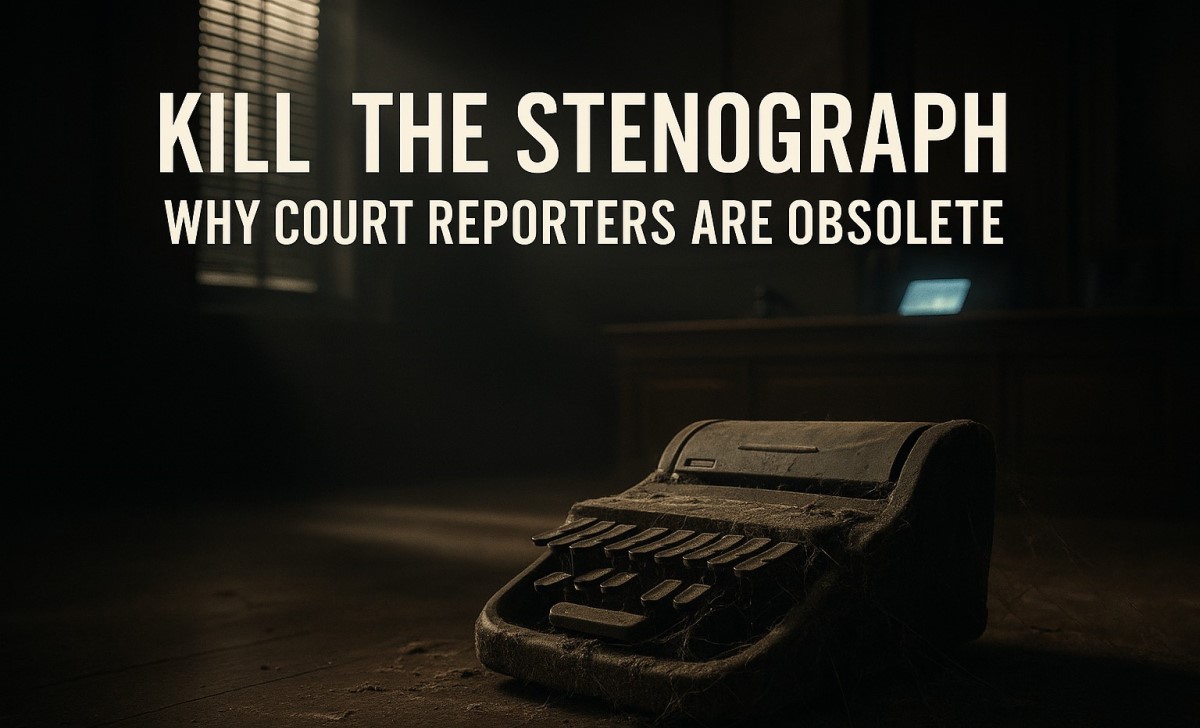
In a world where AI writes legal documents, drives cars, and diagnoses diseases, there’s one dusty corner of the justice system still clinging to 19th-century tech like it’s sacred: the courtroom stenographer.
Ah yes, the hallowed court reporter — perched beside the bench like a loyal altar boy, clacking away at 225 words per minute on a proprietary keyboard no one else understands. Judges love them. Court staff revere them. And if you question their necessity? You might as well spit on the bench.
But here’s the truth: they’re obsolete. And they’re costing all of us — litigants, taxpayers, and appellate lawyers — an absurd amount of time and money for no good reason.
The $4,000 Word Document
Let’s talk numbers.
In many jurisdictions, a full transcript for an appeal can cost upwards of $3,000 to $4,000. That’s not because it’s printed on gold leaf. It’s because someone — a court reporter — took what was already said aloud and retyped it into Microsoft Word. And we’re all supposed to just accept that, like it’s 1993.
This isn’t a shot at the skill. Writing quickly and cleanly is impressive. So is solving a Rubik’s Cube blindfolded. But when the only function is “turn speech into searchable text,” we already have something better: automation.
AI Doesn’t Need a Smoke Break
Modern transcription software — powered by AI and real-time audio processing — can produce usable drafts in seconds. Need searchable text? Instant. Need timestamps? Built-in. Need it within 24 hours? No problem. You don’t have to wait three weeks while someone finishes their backlog or gets around to editing last Tuesday’s trial.
Accuracy? When paired with post-editing (which already happens with human transcripts), it matches or exceeds human speed and correctness. And it doesn’t mishear names because someone coughed or walked by with heels. Machines don’t blink. They don’t daydream. They just do the job.
So why are we still pretending only a certified stenographer can be trusted with the Word doc?
Justice at Human Speed Is Injustice
Appeals move slow enough. Transcripts should never be the bottleneck. But in state courts around the country, appellate lawyers regularly wait weeks or months for transcripts, delaying briefing schedules and wasting judicial resources — all because of an outdated reverence for a glorified typist.
Replace the court reporter with digital recording and speech-to-text software, and transcripts could be ready within 24 hours. With real-time indexing and searchable text, lawyers could file faster, courts could rule faster, and litigants could get decisions without waiting on Cheryl to finish her queue.
The Accuracy Argument Is a Crutch
Ask a judge why court reporters are still used, and you’ll hear the same tired arguments:
“Machines aren’t reliable.”
“Court reporters can interrupt to clarify.”
“We need a human to ensure accuracy.”
Let’s be honest. Every appellate lawyer reading this has seen transcripts with errors. Misspelled names. Mistimed lines. Entire exchanges “inaudible” because the reporter couldn’t keep up. So no — court reporters are not infallible.
And the whole “they can interrupt for clarification” argument? That’s not a feature. That’s a disruption. Trials shouldn’t pause every time someone doesn’t hear a name. A proper mic setup with multi-channel audio eliminates that entirely — and it records everything. Forever.
Judges Just Don’t Want to Let Go
The real reason court reporters persist isn’t necessity. It’s nostalgia.
Judges like having a familiar face beside them. They like the ritual. The solemnity. The illusion of control.
But justice isn’t about aesthetic comfort. It’s about efficiency, fairness, and access. If a robot can do it better, cheaper, and faster — you let the robot do it.
We’re not talking about firing people mid-career with no recourse. We’re talking about phasing out a role that no longer justifies its costs. Court reporters didn’t build the justice system — they just typed it up.
Millions Wasted — For What?
Multiply the $3,000–$4,000 transcript cost across thousands of civil, criminal, and family cases. Consider the delays in rulings. Consider the printing costs, the mailing fees, the hours billed by lawyers waiting for transcripts to arrive. Then imagine:
- Instant digital transcripts
- Searchable databases
- Auto-synced video and audio
- 24-hour turnaround
- Near-zero marginal cost
That’s the system we could have now — if we just stopped protecting the past.
End the Typing. Save the System.
There’s a place for reverence. There’s a place for tradition. But that place is not the transcript department.
Every other sector has automated, streamlined, digitized. The law, for all its pride in precedent, must evolve. And clinging to court reporters in 2025 is like hiring a calligrapher to write your emails.
So let’s say it plainly: it’s time to kill the stenograph.
Not out of cruelty. But out of progress.
Because the courtroom doesn’t need a typist.
It needs a transcript.
And machines do that better.
Image Credit: OpenAI DALL·E.
 Law Office of Jason Ostendorf LLC
Law Office of Jason Ostendorf LLC